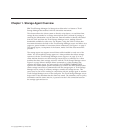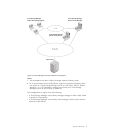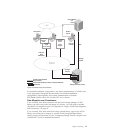
3. A request is made to the storage device to mount the appropriate media.
4. The library manager notifies the storage agent of the location where the
mounted media resides. In the external library case, the storage agent is
informed of the device location by the external library manager.
5. The client, by means of the storage agent, writes the backup data directly to the
device over the SAN.
6. The storage agent sends metadata information to the Tivoli Storage Manager
server, and the server stores the information in its database.
Multi-session No-Query Restore for LAN-free Path
When performing a no-query restore, the Tivoli Storage Manager server builds a
list of files to restore and sends data to the client while continuing to build the list.
This allows the restore to be restarted if interrupted.
Multiple sessions are used for the no-query restore when data for the restore
resides on devices with a LAN-free path and devices with a LAN-only path. Some
sessions restore data from the server with a LAN-only path. The other sessions use
the storage agent to restore data over the LAN-free path. This works only with
clients at Version 4.2 or above.
Note that the number of sessions used for the restore is dependent on the value of
the client RESOURCEUTILIZATION option and the number of server volumes that
contain the client data to be restored.
The following outlines a typical multi-session no-query restore for a LAN-free
path:
1. The client requests a file space to be restored. This request is forwarded to the
server.
2. The server determines the files to restore and the volume on which those files
reside. The server generates a list, sorted by the volume name.
3. The client is informed of the progress and the number of volumes. The client
can start more sessions to restore the information.
4. The location of the volume, and whether or not the storage agent can access the
volume, will determine how the data is handled. When the volume can be
mounted on a shared device that the storage agent can access, the data is read
from the volume by the storage agent and sent to the client. When the volume
cannot be mounted on a shared device that the storage agent can access, the
data is read from the volume by the server and sent directly to the client. The
client then begins additional sessions: some to the storage agent for the
volumes that are LAN-free enabled and some sessions to the server for those
volumes that are not LAN-free enabled.
5. The process repeats until all files in the list are restored.
4 IBM Tivoli Storage Manager for SAN for AIX: Storage Agent User’s Guide


















